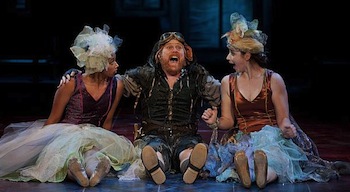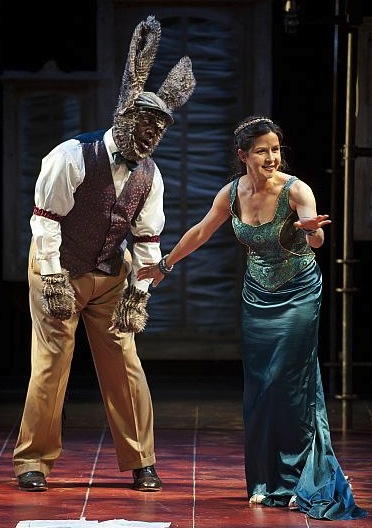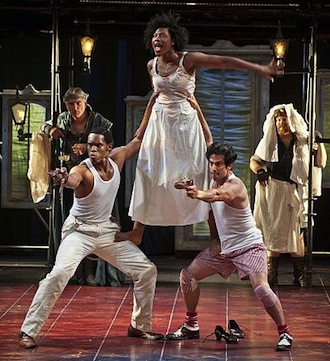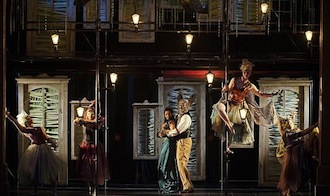
Briana Maia, Michael F. Toomey and Atalanta Seigel. Photo by Kevin Sprague.
By Jeremy D. Goodwin Jazz is a music of possibilities. So too is the music of theater. Even in the midst of a long run, each performance of a given production is meant to rise anew from the mysterious stew of creative possibilities. There’s the sense, even if illusory, that the action could break this way or that way, that the resolution to the onstage events is in doubt. Even with the much-studied words of Shakespeare, the best performers emulate the ineffable kismet of improvisation. Enter the production of A Midsummer Night’s Dream now onstage at Shakespeare & Company. Director Tony Simotes’ inspired conceit is that the enchanted happenings of that play could find full voice when set in an early-20th century New Orleans milieu. It turns out the faded, mysterious, deeply soulful vibe conjured by this vision of New Orleans fits in with the wild journey of Oberon and Puck, Helena and Hermia and all the rest, as snugly as a Harmon mute in the bell of a trumpet.

Johnny Lee Davenport and Merritt Janson. Photo by Kevin Sprague.
Music is everywhere in this production, from the Rude Mechanicals forming a crack band to express their sadness at the disappearance of their compatriot Bottom, to a stomping rendition of “I’ll Fly Away" that begins in the theater lobby. Composer and musical director Alex Sovronsky (who is also onstage as Snug) does much to evoke the sound of New Orleans jazz, and Barbara Allen’s choreography helps turn Theseus’s court into a debauched ballroom. Dangling Spanish moss and curling tree limbs overlap with man-made light fixtures in Travis George’s set design, creating a sense of the creeping influence of the mysterious woods not far from the orderly court. Period-appropriate costumes designed by Deborah A. Brothers work in harmony with Simotes’ vision. Simotes, of course, knows from Midsummer; he played Puck in S&Co.’s first-ever production, on the lawn of The Mount back in 1978. And the play has continued to loom large in the history of the company — though this is only its second turn indoors at the Tina Packer Playhouse (nee Founders’ Theatre), following a 2007 version that felt a little “off-brand," featuring several company newcomers who have not been heard from since.

Rocco Sisto, Colby Lewis, Cloteal L. Horne, David Joseph, and Michael F. Toomey. Photo by Kevin Sprague.
As usual, the success of the play really turns on the four lovers who are set loose in the woods, changing their romantic affections under the influence of a fairy king’s magic. The quartet here is formed by Kelly Galvin and David Joseph, familiar faces who make the most of this featured turn, and S&Co. first-timers Cloteal L. Horne and Colby Lewis. The petite-ness of Galvin’s frame helps fuel the hilarity of a well-executed, acrobatic sequence in which she tosses around Lewis, who plays a sapping but caddish Demetrius. Joseph shows fantastic comedic chops, though Horne’s sledgehammer-y approach suggests she’s still learning the subtleties of massaging the humor in Shakespeare’s text. Rocco Sisto brings a suitably regal air to Oberon, the fairy king. Merritt Janson has winningly played some of Shakespeare’s greatest female roles in this theatre (Desdemona, Rosalind, Viola); here she is a calm, confident Titania. Michael Toomey, whose work at S&Co. and with the Split Knuckle Theater (of which he’s a co-founder) has made him the troupe’s leading clown, is a loud and silly Puck, even if he doesn’t cut loose as much as one might expect.

Photo by Kevin Sprague
The world-weary countenance and achy-bone movements Johnny Lee Davenport gives to Bottom lend an air of pathos, and most of his cohorts among the Rude Mechanicals are also of a certain age. Their subplot feels uncharacteristically played-down here, especially the climactic play-within-a-play which can otherwise pull a production off course by way of prolonged chaos. You kind of want your money’s worth when it comes to the onstage death of Bottom-as-Pyramus, but Davenport doesn’t milk it. Instead, the enduring image from his performance is the beautiful moment when a leftover token from Titania reminds Bottom of the supposed “dream" in which he won her affections. Along the fluid line between waking life and sleep (or, as the play has it, “fairy time") lie infinite possibilities; you can see Bottom glimpse one of those possibilities, and then discard it. It’s deliciously heartbreaking. Helena — not the character, but a friend’s precocious daughter, then five years old — once described a Louis Armstrong solo as “happy and sad together." That’s also the sweet spot of a good Midsummer. This production aims for that note, and hits it. A Midsummer Night's DreamTina Packer Playhouse at Shakespeare & Company 70 Kemble Street, Lenox, MA (413) 637-3353 Now through August 30








